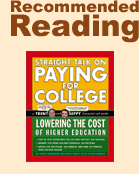
|
Begin a savings plan. Whether your first class begins in six months or six years, starting a savings plan now will reduce the total amount you may need to borrow. If you have a year to save and are able to set aside $100 per month, you’ll have $1200 for tuition and materials – far better than having to repay that same sum if you borrowed it. Use your assets. If you have excess cash set aside for emergencies, funding your education is a smart use for the remainder. Consider selling property you don’t use or need, and peruse your portfolio for investments you would be willing to liquidate. (Keep in mind that parting with assets will likely trigger a tax event.) Another option is to use retirement savings. You can extract funds penalty-free from traditional and Roth IRAs if the money is for higher education expenses. Have a tax-deferred, employer-sponsored retirement plan? You can borrow up to 50 percent of your savings (as much as $50,000), usually at the prime interest rate plus one percent. But consider these options carefully. Not only are there many restrictions, but this is your retirement – money you will need when you are older and can’t or don’t want to work. Don’t raid your funds so aggressively that you’ll be in trouble ten or twenty years down the line. Homeowners have an additional source of low interest, easily attainable cash for educational expenses: the equity amassed in your home. As with retirement money, using home equity should be done with the utmost prudence. If you can’t repay the loan, your residence is at risk. Spend free money. Want money you never have to repay? Look into grants and scholarships. Grants are given based on economic need, and scholarships are generally awarded on merit. Your school will provide information on what may be available to you, but also explore FastWeb.com, Collegeboard.com, and Wiredscholar.com for more information. Even better, your employer may encourage your education. Many companies offer tuition reimbursement plans for those attending undergraduate, graduate, or professional schools. Each plan is different, but most reimburse some portion of an employee’s tuition, books, and related fees. Of course, your compa•ny will want to reap the benefit of all that schooling, so plans typically require you to stay on the job for a specific amount of time after you’ve completed the coursework. Use student loans. Student loans are a common way to pay for tuition and school expenses. With them, you have access to large amounts of cash, very low interest rates, and long, flexible repayment periods. They are readily available and you do not need good credit to take advantage of them. There are two kinds of loans:
Whatever type of loan you are eli•gible for, resist the urge to borrow more than you need. Ask anyone who’s recently gotten a Master’s: paying off student loans is not fun. Reap the tax benefits. The government wants you to expand your intellectual horizons! First, you can deduct student loan interest, and second, you can reduce your income tax liability on a dollar-for-dollar basis with tax credits. The HOPE Scholarship credit is for a student's first two years of undergraduate education, and the Lifetime Learning Credit is for college Juniors, Seniors, Graduate Students and working Americans who are taking classes to upgrade their skills. To find out how tax deductions and credits can work in your favor, visit the IRS’s website: www.irs.gov. Inspired to pick up a course catalogue? Good. Because while paying for higher learning may indeed be financially challenging, an investment in education has a guaranteed return – knowledge. |
||
|
|||

 Though the pursuit of knowledge is among the most worthy of goals, the cost of learning in a formal institution can be formidable. But don’t let the cost deter you. There are plenty of ways to finance your education.
Though the pursuit of knowledge is among the most worthy of goals, the cost of learning in a formal institution can be formidable. But don’t let the cost deter you. There are plenty of ways to finance your education.  Straight Talk on Paying for
College: Lowering the Cost of
Higher Education
Straight Talk on Paying for
College: Lowering the Cost of
Higher Education